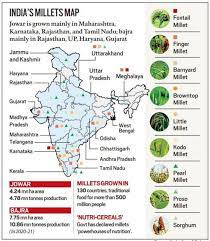Millet production in India has a long history dating back to ancient times. It is an important crop that has been grown for food, feed, and fuel in many parts of the country. Millets are small-seeded grains that are highly nutritious and have a low glycemic index. They are gluten-free and rich in fiber, protein, and minerals like iron, calcium, and magnesium. India is the largest producer of millets in the world, with a production of 11 million metric tons annually. In this article, we will explore the various aspects of millet production in India.

Table of Contents
Types of Millets Grown in India
There are several types of millets grown in India, including sorghum (jowar), finger millet (ragi), pearl millet (bajra), foxtail millet (kangni), little millet (kutki), barnyard millet (sanwa), and kodo millet (kodo). Each type of millet has its unique characteristics and nutritional value.
Sorghum (jowar) is the most widely cultivated millet in India and is grown in both kharif and rabi seasons. It is a rich source of energy, protein, and minerals like calcium, iron, and phosphorus. Finger millet (ragi) is another important millet crop grown in India, especially in the southern states. It is a rich source of calcium, protein, and dietary fiber and has a low glycemic index, making it suitable for people with diabetes.
Pearl millet (bajra) is another popular millet crop grown in India, mainly in the arid and semi-arid regions. It is a rich source of protein, dietary fiber, and minerals like iron and zinc. Foxtail millet (kangni) is a minor millet crop grown in many parts of India, especially in the hilly regions. It is a rich source of dietary fiber and minerals like iron and copper.
Little millet (kutki) is a small-grained millet that is grown in the drier parts of India. It is a rich source of dietary fiber, protein, and minerals like calcium and iron. Barnyard millet (sanwa) is another small-grained millet that is grown in India, especially in the hilly regions. It is a rich source of dietary fiber and minerals like calcium, phosphorus, and iron. Kodo millet (kodo) is another small-grained millet that is grown in India. It is a rich source of protein, dietary fiber, and minerals like iron and zinc.
Millets Production in India
Millets are grown in many parts of India, including Andhra Pradesh, Telangana, Karnataka, Tamil Nadu, Maharashtra, Gujarat, Rajasthan, Uttar Pradesh, and Madhya Pradesh. The millet production in India has been increasing steadily over the years due to the efforts of the government and various non-governmental organizations.
The government of India has launched several programs to promote the cultivation of millets in the country. The Millets Mission, launched in 2018, aims to increase the production of millets and promote their consumption for better nutrition and health. Under this mission, the government is providing various incentives and subsidies to farmers to encourage them to cultivate millets.
Non-governmental organizations like the Millet Network of India and the International Crops Research Institute for the Semi-Arid Tropics (ICRISAT) are also working to promote the cultivation of millets in India. They are providing technical assistance, training, and support to farmers to improve their millet cultivation practices.
Benefits of Millet Production in India
The production of millets in India has several benefits, both for the farmers and the consumers. For farmers, millets are an important crop that can grow in low rainfall conditions and on marginal lands. They have a short crop cycle and require fewer inputs like fertilizers and pesticides, making them a more sustainable and cost-effective option. Millets also have a high yield potential, with some varieties yielding up to 3-4 tons per hectare.
For consumers, millets are a nutritious and healthy food option that can help improve their overall health and well-being. They are gluten-free and have a low glycemic index, making them suitable for people with celiac disease and diabetes. Millets are also rich in dietary fiber, protein, and minerals like iron, calcium, and magnesium, which can help prevent malnutrition and micronutrient deficiencies.
Challenges in Millet Production in India
Despite the many benefits of millet production in India, there are also several challenges that need to be addressed. One of the main challenges is the lack of awareness and demand for millets among consumers. Millets are often seen as a poor man’s food or a food of the past and are not valued as much as other crops like rice and wheat. This leads to lower prices for millets and lower profits for farmers.
Another challenge is the lack of infrastructure and marketing facilities for millets. Unlike other crops, there are no well-established markets for millets, and farmers often have to sell their produce at lower prices to middlemen or traders. There is also a lack of processing and value addition facilities for millets, which limits their potential for use in other food products like breakfast cereals, snacks, and bakery items.
Conclusion
In conclusion, millet production in India has the potential to provide many benefits, both for the farmers and the consumers. Millets are a sustainable and nutritious crop that can help improve the livelihoods of smallholder farmers and promote better nutrition and health among consumers. However, to realize these benefits, there is a need for greater awareness and demand for millets among consumers, as well as investments in infrastructure and marketing facilities for millets. With the right policies and investments, millet production in India can play a key role in promoting sustainable agriculture and improving food security and nutrition.
Important Links